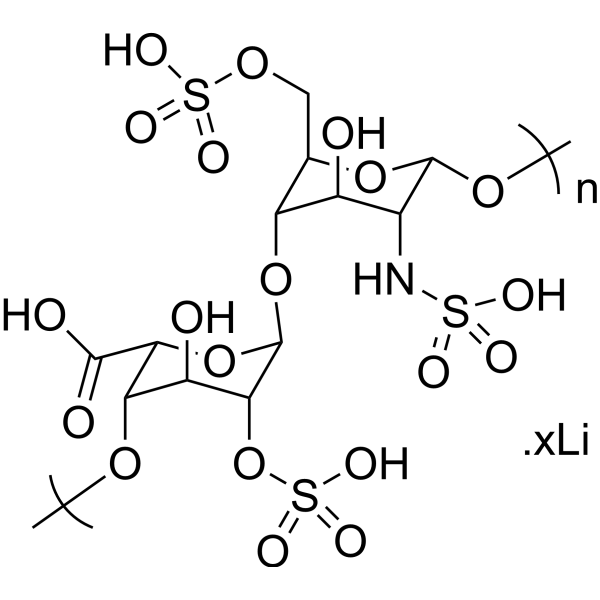| Cas No.: | 9045-22-1 |
| Chemical Name: | Heparin lithium salt |
| Synonyms: | Heparin lithium salt;Heparin lithium salt from porcine intestinal mucosa;heparin lithium from porcine*intestinal mucosa;Heparin, Lithium Salt, PorcineIntestinal Mucosa;Heparin lithium;~200 units;mg];Calcium balanced heparin lithium;Heparin Lithium salt |
| SMILES: | O[C@H]1[C@H](O[C@H]2[C@H](OS(O)(=O)=O)[C@@H](O)[C@H](OC)[C@H](C(O)=O)O2)[C@@H](COS(O)(=O)=O)O[C@H](OC)[C@@H]1NS(O)(=O)=O.[n].[.xLi] |
| Formula: | C9H8O2 |
| M.Wt: | 148.15862 |
| Purity: | >98% |
| Sotrage: | 2 years -20°C Powder, 2 weeks 4°C in DMSO, 6 months -80°C in DMSO |
| Description: | Heparin Lithium salt is an anticoagulant which binds reversibly to antithrombin III (ATIII). |
| In Vitro: | Heparin is a potent anticoagulant drug based on its ability to accelerate the rate at which antithrombin inhibits serine proteases in the blood coagulation cascade. Heparin interactes most tightly with peptides containing a complementary binding site of high positive charge density. Heparin resembles DNA as both are highly charged linear polymers that behave as polyelectrolytes. Heparin is believed to function as an anticoagulant primarily through its interaction with AT III by enhancing AT-III-mediated inhibition of blood coagulation factors, including thrombin and factor Xa. Heparin binds to AT III and thrombin in a ternary complex, increasing the bimolecular rate constant for the inhibition of thrombin by a factor of 2000. Heparin is principally located in the granules of tissue mast cells that are closely associated with the immune response. Heparin makes numerous contacts with both FGF-2 and FGFR-1 stabilizing FGF–FGFR binding. Heparin also makes contacts with the FGFR-1 of the adjacent FGF–FGFR complex, thus seeming to promote FGFR dimerization[1]. |

 To enhance service speed and avoid tariff delays, we've opened a US warehouse. All US orders ship directly from our US facility.
To enhance service speed and avoid tariff delays, we've opened a US warehouse. All US orders ship directly from our US facility.




















